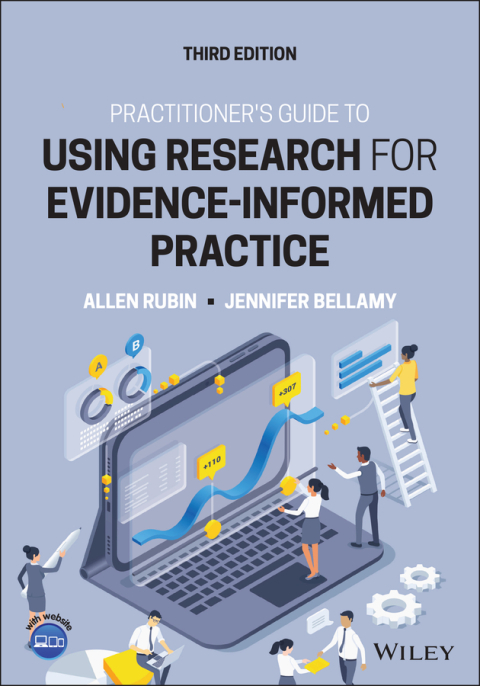Description
Efnisyfirlit
- COVER
- TITLE PAGE
- COPYRIGHT
- PREFACE
- Organization and Special Features
- Significant Additions to This Edition
- ACKNOWLEDGEMENTS
- ABOUT THE AUTHORS
- ABOUT THE COMPANION WEBSITE
- PART 1: OVERVIEW OF EVIDENCE-INFORMED PRACTICE
- 1 Introduction to Evidence-Informed Practice (EIP)
- 1.1 Emergence of EIP
- 1.2 Defining EIP
- 1.3 Types of EIP Questions
- 1.4 EIP Practice Regarding Policy and Social Justice
- 1.5 EIP and Black Lives Matter
- 1.6 Developing an EIP Practice Process Outlook
- 1.7 EIP as a Client-Centered, Compassionate Means, Not an End unto Itself
- 1.8 EIP and Professional Ethics
- Key Chapter Concepts
- Additional Reading
- 2 Steps in the EIP Process
- 2.1 Step 1: Question Formulation
- 2.2 Step 2: Evidence Search
- 2.3 Step 3: Critically Appraising Studies and Reviews
- 2.4 Step 4: Selecting and Implementing the Intervention
- 2.5 Step 5: Monitor Client Progress
- 2.6 Feasibility Constraints
- 2.7 But What about the Dodo Bird Verdict?
- Key Chapter Concepts
- Additional Reading
- 3 Research Hierarchies: Which Types of Research Are Best for Which Questions?
- 3.1 More than One Type of Hierarchy for More than One Type of EIP Question
- 3.2 Qualitative and Quantitative Studies
- 3.3 Which Types of Research Designs Apply to Which Types of EIP Questions?
- Key Chapter Concepts
- Additional Reading
- PART 2: CRITICALLY APPRAISING STUDIES FOR EIP QUESTIONS ABOUT INTERVENTION EFFECTIVENESS
- 4 Criteria for Inferring Effectiveness: How Do We Know What Works?
- 4.1 Internal Validity
- 4.2 Measurement Issues
- 4.3 Statistical Chance
- 4.4 External Validity
- 4.5 Synopses of Fictitious Research Studies
- Key Chapter Concepts
- Exercise for Critically Appraising Published Articles
- Additional Reading
- 5 Critically Appraising Experiments
- 5.1 Classic Pretest-Posttest Control Group Design
- 5.2 Posttest-Only Control Group Design
- 5.3 Solomon Four-Group Design
- 5.4 Alternative Treatment Designs
- 5.5 Dismantling Designs
- 5.6 Placebo Control Group Designs
- 5.7 Experimental Demand and Experimenter Expectancies
- 5.8 Obtrusive Versus Unobtrusive Observation
- 5.9 Compensatory Equalization and Compensatory Rivalry
- 5.10 Resentful Demoralization
- 5.11 Treatment Diffusion
- 5.12 Treatment Fidelity
- 5.13 Practitioner Equivalence
- 5.14 Differential Attrition
- 5.15 Synopses of Research Studies
- Key Chapter Concepts
- Exercise for Critically Appraising Published Articles
- Additional Reading
- 6 Critically Appraising Quasi-Experiments: Nonequivalent Comparison Groups Designs
- 6.1 Nonequivalent Comparison Groups Designs
- 6.2 Additional Logical Arrangements to Control for Potential Selectivity Biases
- 6.3 Statistical Controls for Potential Selectivity Biases
- 6.4 Creating Matched Comparison Groups Using Propensity Score Matching
- 6.5 Pilot Studies
- 6.6 Synopses of Research Studies
- Key Chapter Concepts
- Exercise for Critically Appraising Published Articles
- Additional Reading
- 7 Critically Appraising Quasi-Experiments: Time-Series Designs and Single-Case Designs
- 7.1 Simple Time-Series Designs
- 7.2 Multiple Time-Series Designs
- 7.3 Single-Case Designs
- 7.4 Synopses of Research Studies
- Key Chapter Concepts
- Exercise for Critically Appraising Published Articles
- Additional Reading
- 8 Critically Appraising Systematic Reviews and Meta-Analyses
- 8.1 Advantages of Systematic Reviews and Meta-Analyses
- 8.2 Risks in Relying Exclusively on Systematic Reviews and Meta-Analyses
- 8.3 Where to Start
- 8.4 What to Look for When Critically Appraising Systematic Reviews
- 8.5 What Distinguishes a Systematic Review from Other Types of Reviews?
- 8.6 What to Look for When Critically Appraising Meta-Analyses
- 8.7 Synopses of Research Studies
- Key Chapter Concepts
- Exercise for Critically Appraising Published Articles
- Additional Reading
- PART 3: CRITICALLY APPRAISING STUDIES FOR ALTERNATIVE EIP QUESTIONS
- 9 Critically Appraising Nonexperimental Quantitative Studies
- 9.1 Surveys
- 9.2 Cross-Sectional and Longitudinal Studies
- 9.3 Case-Control Studies
- 9.4 Synopses of Research Studies
- Key Chapter Concepts
- Exercise for Critically Appraising Published Articles
- Additional Reading
- 10 Critically Appraising Qualitative Studies
- 10.1 Qualitative Observation
- 10.2 Qualitative Interviewing
- 10.3 Other Qualitative Methodologies
- 10.4 Qualitative Sampling
- 10.5 Grounded Theory
- 10.6 Alternatives to Grounded Theory
- 10.7 Frameworks for Appraising Qualitative Studies
- 10.8 Mixed Model and Mixed Methods Studies
- 10.9 Synopses of Research Studies
- Key Chapter Concepts
- Exercise for Critically Appraising Published Articles
- Additional Reading
- PART 4: ASSESSMENT AND MONITORING IN EVIDENCE-INFORMED PRACTICE
- 11 Critically Appraising, Selecting, and Constructing Assessment Instruments
- 11.1 Reliability
- 11.2 Validity
- 11.3 Feasibility
- 11.4 Sample Characteristics
- 11.5 Locating Assessment Instruments
- 11.6 Constructing Assessment Instruments
- 11.7 Synopses of Research Studies
- Key Chapter Concepts
- Exercise for Critically Appraising Published Articles
- Additional Reading
- 12 Monitoring Client Progress
- 12.1 A Practitioner-Friendly Single-Case Design
- 12.2 Using Within-Group Effect-Size Benchmarks
- Key Chapter Concepts
- Additional Reading
- PART 5: ADDITIONAL ASPECTS OF EVIDENCE-INFORMED PRACTICE
- 13 Appraising and Conducting Data Analyses in EIP
- 13.1 Introduction
- 13.2 Ruling Out Statistical Chance
- 13.3 What Else Do You Need to Know?
- 13.4 The 05 Cutoff Point Is Not Sacred!
- 13.5 What Else Do You Need to Know?
- 13.6 Calculating Within-Group Effect Sizes and Using Benchmarks
- 13.7 Conclusion
- Key Chapter Concepts
- Additional Reading
- 14 Critically Appraising Social Justice Research Studies
- 14.1 Introduction
- 14.2 Evidence-Informed Social Action
- 14.3 What Type of Evidence?
- 14.4 Participatory Action Research (PAR)
- 14.5 Illustrations of Other Types of Social Justice Research
- 14.6 Conclusion
- Key Chapter Concepts
- Additional Reading
- Note
- GLOSSARY
- REFERENCES
- INDEX
- END USER LICENSE AGREEMENT






Reviews
There are no reviews yet.